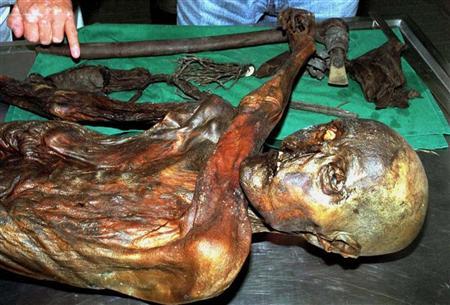The first complete genome-sequencing of “Otzi,” Italy’s prehistoric iceman, is revealing a wealth of details about the man who roamed the Alps 5,300 years ago and could unleash a frenzy of activity among scientists thanks to open data.

Over the last 20 years, scientists have painstakingly collected data from the stomach, bowels and teeth of the 45-year old man, who was found sticking out of a glacier by German climbers in 1991 in the Tyrolean Alps on the Austro-Italian border.
But for the first time since the Copper-age individual was unearthed, his complete genetic profile has been reconstituted, revealing a very modern predisposition for cardiovascular diseases, lactose intolerance, and brown eyes that betray near-Eastern origins.
“He is more closely related to modern Sardinian or Corsican populations than, for instance, mainland Italy further to the south,” Angela Graefen, a human genetics researcher at the Eurac Institute for the Mummies and the Iceman in Bolzano, Italy, told Reuters on Thursday.
“But that doesn’t mean he comes from Sardinia or Corsica,” noted the scientist, one of the principal writers on a study published in the Nature Communications journal this week.
“His ancestors were more plausibly from the first wave of migrants from the Near East. The genome group stuck in the isolated regions which were less affected by human migrations, Mediterranean islands but also remote Alpine valleys.”
Otzi, a hunter who was felled by an arrow while climbing the high mountains, was also predisposed to arteriosclerosis and heart diseases, conditions thought to be more linked to modern risk factors such as being overweight, smoking or drinking.
“We know he was a very active person. He was not the type of person who would sit around in a sedentary fashion. It also seems he ate in a healthy fashion,” Graefen said.
“So it could be that the genetics count for more than we might have thought previously (for modern conditions such as cardiovascular diseases,” she added.
The research helps flesh out a picture of the iceman, who had brown hair, type-O blood, the lactose intolerance that was common among Neolithic agrarian societies. He also was the first-known carrier of Lyme disease, a bacterial infection spread by ticks.
But the full-genome sequencing also opens far more possibilities for researchers around the globe than the 2008 sequencing of his mitochondrial DNA — which is passed down through the mother’s line.
“This is more information than we could probably study in a lifetime,” Eurac’s Graefen said. “That’s why we have made the data public on a special browser so that a specialist in any field can look this up.”
“There are millions of genes out there which have yet to be identified. In the future, when we know what a particular gene is for, we can check what it was like 5,000 years ago,” she said.
Since Otzi’s mummified body was found 20 years ago, speculation about his lifestyle, how he died and even his sexuality have flourished in German, Austrian and Italian newspapers.
One sticky rumor was that semen had been found in his anal canal, prompting headlines about his supposed homosexuality. But Graefen set the record straight.
“This comes from the fact that seeds have been found in his intestine. The words for plant seeds and semen are actually the same in German,” she laughed.
“People still to this day think this urban legend is true. But this is nothing more than a translation fault,” she added.
(Reporting by Michel Rose, editing by Paul Casciato)

